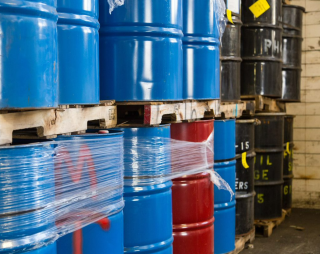Used Drum Management and Reconditioning
On this page:
- Background
- Resource Conservation and Recovery Act Regulations
- EPA's Damage Case Report
- Used Drum Management and Reconditioning Advance Notice of Proposed Rulemaking
- Additional Resources
Background
Drums, or industrial containers, are used to transport thousands of different types of materials including:
-

- Acids (and other corrosives).
- Oils.
- Solvents.
- Paints.
- Resins.
- Adhesives.
- Soaps.
- Food.
- Wastes and residues.
Reusable drums or containers can be made of fiber, steel, plastic/high-density polyethylene or a combination of plastic and steel (intermediate bulk containers). Once used, these drums are discarded in a landfill, recycled, or reconditioned or refurbished for reuse. The reconditioning and recycling processes provide important economic and environmental advantages because they consume less energy and resources to meet the demand for industrial containers.
Drum reconditioning facilities clean and recondition steel and plastic drums and IBCs for resale and reuse by cleaning, restoring, testing, and certifying these industrial containers. These containers may have previously contained hazardous or other materials listed above. The two main processes used for reconditioning are:
- Burning off residuals from metal drums in a drum furnace.
- Washing metal and plastic drums or containers with water and a caustic solution to clean out residues.
Generators who manage and ship containers that previously held hazardous materials or hazardous waste to drum reconditioning facilities are required to ensure that the drums are sufficiently empty to comply with the RCRA empty container provision.
RCRA Regulations
The empty container provision, found in Title 40 of the Code of Federal Regulations in Section 261.7, exempts from regulation hazardous waste residues that remain in drums or other containers if a number of conditions are met. One of the conditions is that all wastes must be removed from the containers by pouring, pumping, aspirating, etc. There are different conditions to be met in order to deem a container empty for non-acute hazardous waste and for acute hazardous waste. Containers that meet the conditions of this exemption are typically referred to as “RCRA empty” containers.
If the regulations are followed correctly by all generators of used drums, only completely empty or “RCRA empty” containers are shipped to drum reconditioners to be cleaned, restored, tested, and reused. Despite this exemption, drum reconditioners are still receiving containers that do not meet the conditions of 40 CFR Section 261.7 and are likely accepting many drums of hazardous waste that are not actually “RCRA empty.” Additionally, even if drum reconditioners receive only “RCRA empty” containers, they may still receive and manage significant quantities of cumulative hazardous waste residues because of the sheer volume of containers they process. As a result, these facilities are potentially managing large quantities of hazardous waste without a provision in the regulations that allows drum reconditioners to store rejected non-empty hazardous waste containers and without being subject to substantive RCRA hazardous waste regulations.
EPA's Damage Case Report
In September 2022, EPA completed a Drum Reconditioner Damage Case Report to improve our understanding of how the drum reconditioner industry operates. The report also documents incidents at these facilities that caused damage to human health and the environment. This report serves to inform policymakers, enforcement officials, and the public about the regulatory and waste issues surrounding drum reconditioning facilities. EPA is engaging interested entities on possible approaches to addressing and mitigating these issues.
Used Drum Management and Reconditioning Advance Notice of Proposed Rulemaking
On August 11, 2023, EPA issued the Used Drum Management and Reconditioning Advance Notice of Proposed Rulemaking to assist in addressing concerns about used industrial containers that previously held hazardous chemicals or hazardous waste.
In November, EPA hosted a virtual meeting to discuss the ANPRM and learn more about the challenges communities face. Read about the November public meeting
